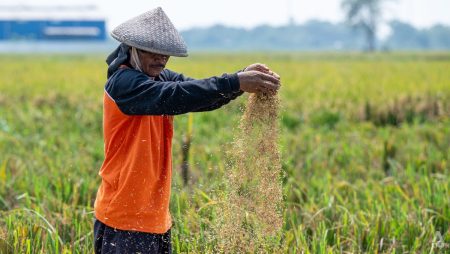On a seemingly ordinary Friday morning in the Bronx, New York, a casual dog walk took a horrific turn for 34-year-old Tayquon Young. While walking his 4-year-old pit bull, Chanel, Young encountered another dog walker. According to Young’s account, Chanel, who was leashed, and the other, unleashed dog, began interacting, sparking a confrontation between the two owners. The other dog walker, angered by the interaction, allegedly threatened to harm Chanel and subsequently brandished a machete, a blade exceeding two feet in length, concealed within his coat. In a desperate attempt to protect himself and his dog, Young instinctively reached out to deflect the impending blow, but the sharp blade severed four of his fingers.
The sudden and brutal attack left Young in shock and disbelief. Instead of receiving immediate assistance, he recounted a disturbing scene where onlookers, seemingly more captivated by the spectacle than moved to help, recorded the incident on their phones. He had to implore them to call 911 for help. This chilling detail underscores a concerning societal trend where the impulse to document events, even traumatic ones, can supersede the instinct to offer aid. The attacker fled the scene, leaving Young bleeding and mutilated, his severed fingers scattered on the ground. Emergency services rushed him to a nearby hospital, while Chanel, thankfully, remained unharmed.
At the hospital, medical professionals embarked on a painstaking 13-hour surgery to reattach three of Young’s severed fingers, the fourth remaining lost in the chaos of the attack. While recovering from the surgery, Young described the lingering trauma, both physical and psychological. The numbness from the anesthesia masked the physical pain, but the emotional scars remained raw. He recounted experiencing flashbacks of the attack, the image of the blade descending and the sensation of impact replaying in his mind. The incident cast a long shadow of uncertainty over Young’s future, particularly concerning his ability to continue his work as a maintenance worker for the Metropolitan Transportation Authority, a job requiring manual dexterity.
The incident sparked outrage and concern within Young’s family and the broader community. His mother, Kimtreese Young, expressed her anguish and fear, describing the attacker as a “maniac” and calling for his apprehension and treatment. Young’s uncle, Andrew Price, lamented the escalating violence in the Bronx, expressing a growing sense of insecurity and the chilling question of whether carrying a weapon for self-defense is now a necessity. This sentiment reflects the pervasive fear that can grip communities grappling with high crime rates and underscores the broader societal implications of such violent incidents.
The NYPD launched an investigation into the attack, seeking to identify and apprehend the perpetrator. Based on witness accounts and Young’s description, the suspect is believed to be a male between 40 and 50 years old, approximately 5 feet 10 inches tall. He was last seen wearing a distinctive outfit: a tan bucket hat, gray hooded sweatshirt, green vest, and tan boots. As the investigation continues, the hope remains that the attacker will be brought to justice, offering some measure of solace to Young and his family, and perhaps contributing to a sense of restored safety in the community.
This disturbing incident reveals the undercurrents of violence that can unexpectedly erupt in everyday life, shattering the normalcy of routine activities like walking a dog. It also highlights the complex interplay of factors contributing to such events, from individual anger and aggression to broader societal issues like rising crime rates and the desensitizing effect of constant exposure to violence, both real and virtual. The incident serves as a stark reminder of the importance of community safety and the need for effective strategies to prevent and address violence in all its forms. The act of recording the incident rather than helping, as witnessed by Young, also raises crucial questions about the changing nature of empathy and responsibility in a digitally connected world.










